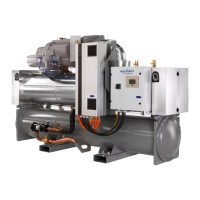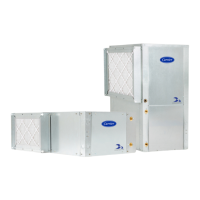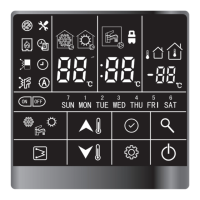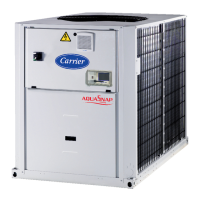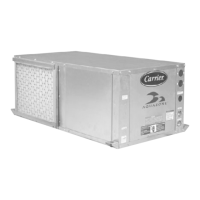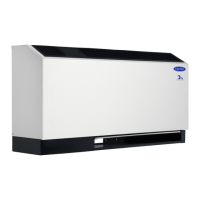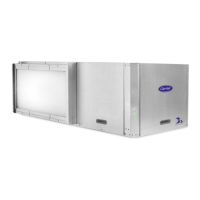23
8 - OPERATING MODE FOR HEAT PUMP UNITS 61XWH
8.1 - Heating mode
Unlike in the cooling mode, the unit uses the heating setpoint in
this conguration. The evaporator leaving water control (lowest
setpoint taken into consideration) is still maintained to prevent
operation at very low temperatures.
8.2 - Simultaneous operating use (Heating and
cooling):
Sometimes the customer need to recover the cooling production
in parrallel than the main use heating. In this case, a cooling
setpoint could be prefered than standard heating setpoint.
9 - MAJOR SYSTEM COMPONENTS AND OPERATION DATA
9.1 - Direct-drive twin-screw compressor with
variable capacity slide valve
The unit uses 06T geared twin-screw compressors equipped with
a variable capacity slide valve for continuous control between 50%
and 100% of full load.
9.1.1 - Oil lter
The 06T screw compressor has an independent oil lter.
9.1.2 - Refrigerant
The unit is a water source heat pump operating only with refrigerant
R1234ze(E)
9.1.3 - Lubricant
The 06T screw compressor is approved for use with the following
lubricant: CARRIER MATERIAL SPEC PP 47-38.
9.1.4 - Oil supply solenoid valve
An oil supply solenoid valve is installed on the oil return line as
standard to isolate the compressor from oil flow when the
compressor is not operating. The oil solenoid valve is field
replaceable.
9.1.5 - Capacity control system
The 06T screw compressor has an unloading system that is
standard on all compressors. This unloading system consists of
slide valve that permits changing the length of the screw used for
the refrigerant compression. This valve is controlled by the action
of a piston controlled by two solenoid valves on the oil return line.
9.1.6 - Liquid injection line
The liquid injection line includes a shut-off valve and an electronic
expansion valve. It permits to reach higher condensing temperature
keeping limited discharge temperature.
9.2 - Pressure vessels
General
To remove an apparent discrepancy between TS maxi of
components and of the high pressure side of the unit, refer to the
note in 3.1.
Monitoring during operation, re-qualication, re-testing and re-
testing dispensation:
• Follow the regulations on monitoring pressurised equipment.
• It is normally required that the user or operator sets up and
maintains a monitoring and maintenance le.
• If no regulations exist or to complement regulations, follow
the control programmes of EN 378.
• If they exist follow local professional recommendations.
• Regularly inspect the condition of the coating (paint) to
detect blistering resulting from corrosion. To do this, check
a non-insulated section of the container or the rust formation
at the insulation joints.
• Regularly check for possible presence of impurities
(e.g. silicon grains) in the heat exchange uids. These impurities
maybe the cause of the wear or corrosion by puncture.
• Filter the coolant and carry out internal inspections as
described in EN 378.
• In case of re-testing please refer to the maximum operating
pressure given on the unit nameplate.
• The reports of periodical checks by the user or operator
must be included in the supervision and maintenance le.
Repair
Any repair or modication, including the replacement of moving
parts:
• must follow local regulations and be made by qualied
operators and in accordance with qualied procedures,
including changing the heat exchanger tubes.
• must be made in accordance with the instructions of the
original manufacturer. Repair and modification that
necessitate permanent assembly (soldering, welding,
expanding etc.) must be made using the correct procedures
and by qualied operators.
• An indication of any modication or repair must be shown
in the monitoring and maintenance le.
Recycling
The unit is wholly or partly recyclable. After use it contains
refrigerant vapours and oil residue. It is coated by paint.
Operating life
The evaporator and oil separator are designed for:
• prolonged storage of 15 years under nitrogen charge with
a temperature difference of 20K per day.
• 452000 cycles (start-ups) with a maximum difference of 6 K
between two neighbouring points in the vessel, based on 6
start-ups per hour over 15 years at a usage rate of 57%.
Corrosion allowances
Gas side: 0 mm
Heat exchange uid side: 1 mm for tubular plates in lightly alloyed
steels, 0 mm for stainless steel plates or plates with copper-nickel
or stainless steel protection.
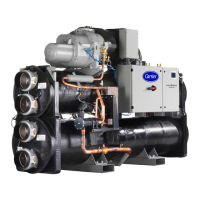
